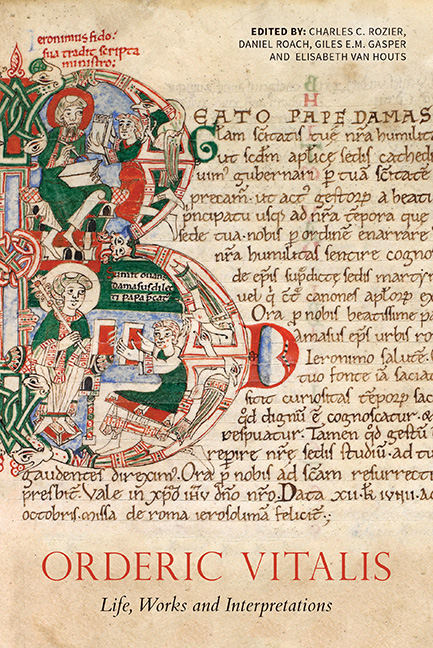Book contents
- Frontmatter
- Dedication
- Contents
- List of Illustrations
- Acknowledgements
- List of Abbreviations
- Chronology of the Lives of Odelerius and his Son Orderic Vitalis
- Composition of the Historia ecclesiastica
- Introduction: Interpreting Orderic Vitalis
- Orderic and his Father, Odelerius
- Following the Master's Lead: The Script of Orderic Vitalis and the Discovery of a New Manuscript (Rouen, BM, 540)
- Orderic Vitalis as Librarian and Cantor of Saint-Évroul
- Saint-Évroul and Southern Italy in Orderic's Historia ecclesiastica
- Orderic and English
- Inscriptions in Orderic's Historia ecclesiastica: A Writing Technique between History and Poetry
- Reading Orderic with Charters in Mind
- Orderic Vitalis and the Cult of Saints
- Orderic's Secular Rulers and Representations of Personality and Power in the Historia ecclesiastica
- Worldly Woe and Heavenly Joy: The Tone of the Historia ecclesiastica
- Orderic Vitalis, Historical Writing and a Theology of Reckoning
- Jesus Christ, a Protagonist of Anglo-Norman History? History and Theology in Orderic Vitalis's Historia ecclesiastica
- ‘Studiosi abdita investigant’: Orderic Vitalis and the Mystical Morals of History
- Meanders, Loops, and Dead Ends: Literary Form and the Common Life in Orderic's Historia ecclesiastica
- Orderic and the Tironensians
- ‘One single letter remained in excess of all his sins …’: Orderic Vitalis and Cultural Memory
- The Reception of Orderic Vitalis in the Later Middle Ages
- Appendix 1 Archaeological Investigations at the Abbey of Saint-Évroult-Notre-Dame-des-Bois
- Appendix 2 Descriptive Catalogue of Manuscripts Featuring the Hand of Orderic Vitalis
- Select Bibliography
- List of Manuscripts Cited
- General Index
Orderic and the Tironensians
Published online by Cambridge University Press: 25 October 2017
- Frontmatter
- Dedication
- Contents
- List of Illustrations
- Acknowledgements
- List of Abbreviations
- Chronology of the Lives of Odelerius and his Son Orderic Vitalis
- Composition of the Historia ecclesiastica
- Introduction: Interpreting Orderic Vitalis
- Orderic and his Father, Odelerius
- Following the Master's Lead: The Script of Orderic Vitalis and the Discovery of a New Manuscript (Rouen, BM, 540)
- Orderic Vitalis as Librarian and Cantor of Saint-Évroul
- Saint-Évroul and Southern Italy in Orderic's Historia ecclesiastica
- Orderic and English
- Inscriptions in Orderic's Historia ecclesiastica: A Writing Technique between History and Poetry
- Reading Orderic with Charters in Mind
- Orderic Vitalis and the Cult of Saints
- Orderic's Secular Rulers and Representations of Personality and Power in the Historia ecclesiastica
- Worldly Woe and Heavenly Joy: The Tone of the Historia ecclesiastica
- Orderic Vitalis, Historical Writing and a Theology of Reckoning
- Jesus Christ, a Protagonist of Anglo-Norman History? History and Theology in Orderic Vitalis's Historia ecclesiastica
- ‘Studiosi abdita investigant’: Orderic Vitalis and the Mystical Morals of History
- Meanders, Loops, and Dead Ends: Literary Form and the Common Life in Orderic's Historia ecclesiastica
- Orderic and the Tironensians
- ‘One single letter remained in excess of all his sins …’: Orderic Vitalis and Cultural Memory
- The Reception of Orderic Vitalis in the Later Middle Ages
- Appendix 1 Archaeological Investigations at the Abbey of Saint-Évroult-Notre-Dame-des-Bois
- Appendix 2 Descriptive Catalogue of Manuscripts Featuring the Hand of Orderic Vitalis
- Select Bibliography
- List of Manuscripts Cited
- General Index
Summary
The section of Orderic's Historia ecclesiastica that has become known as his ‘Treatise on the New Orders’ is a valuable insight into the great wave of change that had swept through Western monasticism in his lifetime. At the time he was writing the Cistercians were emerging as the strongest voice in what Marjorie Chibnall described as the ‘great debate on the interpretation of the Rule’. While Orderic begins his consideration with the Cistercians, he has important things to say about other monastic initiatives too. He provides, for example, an account of the foundation made at Tiron in the forests of the Perche in the first decade of the twelfth century. Little has been written about the monks of Tiron, although they were during Orderic's lifetime one of the most successful of the new approaches to monasticism, if success is to be measured by the settlement of Tironensian monks all over northern France, Normandy, Anjou, Poitou, Burgundy, Scotland, England and Wales. Orderic's is an early and independent account of the rise of the Tironensian congregation, and it is important because the history of the Tironensians has always been dominated by the life of the founder, Abbot Bernard, the Vita beati Bernardi Tironensis (Bibliotheca Hagiographica Latina no. 1251). Orderic captures the stories that had gathered around the founding figure some twenty years after Bernard's death and, as such, is a witness to what can be described as the ‘Bernard of Tiron narrative’, before that narrative reached its fullest expression in the Vita. In considering Orderic's treatment of events at Tiron, then, our understanding of one of the more obscure of the so-called new monastic orders will be increased. Another look at the treatise in a Tironensian context will also be helpful in providing a new perspective on the sources Orderic used in the composition of the Historia ecclesiastica.
Orderic's record of the events that led up to the foundation of Tiron starts with the departure from Poitou of the abbot of Quinçay, Bernard, who left his house because he was unwilling to accept that it should be subject to Cluny.
- Type
- Chapter
- Information
- Orderic Vitalis: Life, Works and Interpretations , pp. 324 - 332Publisher: Boydell & BrewerPrint publication year: 2016



